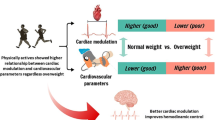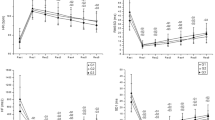Abstract
Objectives
To investigate the association of different measures of central (abdominal) and overall adiposity with autonomic nervous system (ANS) function, indexed by heart rate variability (HRV), in apparently healthy human adults.
Design and Measurements
Cross-sectional data of 8,538 participants (20% female, age: 41 ± 11 years, body mass index (BMI): 24 ± 4 kg/m2, waist circumference (WC): 91 ± 12 cm, waist-to-height ratio (WHtR): 0.45 ± 0.08) were available for analysis.
Results
All measures of adiposity were inversely correlated with vagally-mediated HRV indexed by RMSSD (all p<0.001). Strongest associations were found with WC and RMSSD (r = -0.29). Associations were stronger in males (WC r = -0.32) than in females (WC r = -0.23). Partial correlations revealed the same pattern for RMSSD (WC all pcc = -0.12 p<0.001; WC male pcc = -0.14 p<0.001; WC female pcc = -0.06 p<0.05). Correlation strength of BMI and WHtR with RMSSD were similar and significantly weaker compared to WC (p <.001) in unadjusted analysis. Overall, nonparametric Kendall’s tb led to the same conclusions.
Conclusion
The present data supports previous findings, that HRV is related to measures of adiposity in healthy individuals. In line with previous research, we found that WC is more strongly related to measures of HRV, indicating that WC best captures adiposity related risk.
Similar content being viewed by others
References
Hubert HB, Feinleib M, McNamara PM, Castelli WP. Obesity as an independent risk factor for cardiovascular disease: a 26-year follow-up of participants in the Framingham Heart Study. Circulation. 1983; 67 (5): 968–77.
Mokdad AH, Ford ES, Bowman BA, Dietz WH, Vinicor F, Bales VS, Marks JS. Prevalence of obesity, diabetes, and obesity-related health risk factors, 2001. JAMA. 2003; 289 (1): 76–79.
Malik VS, Willett WC & Hu FB. Global obesity: trends, risk factors and policy implications. Nature Reviews Endocrinology 2012; 9 (1): 13–27.
Lim SS, Vos T, Flaxman AD et al. A comparative risk assessment of burden of disease and injury attributable to 67 risk factors and risk factor clusters in 21 regions, 1990–2010: a systematic analysis for the Global Burden of Disease Study 2010. The Lancet 2012; 380 (9859): 2224–60.
Finucane MM, Stevens GA, Cowan MJ et al. National, regional, and global trends in body-mass index since 1980: systematic analysis of health examination surveys and epidemiological studies with 960 country-years and 9.1 million participants. The Lancet 2011; 377 (9765): 557–567.
Romero-Corral A, Somers VK, Sierra-Johnson J, Korenfeld Y, Boarin S, Korinek J, Jensen MD, Parati G, Lopez-Jimenez F. Normal weight obesity: a risk factor for cardiometabolic dysregulation and cardiovascular mortality. Eur Heart J. 2010; 31 (6): 737–746.
Ashwell M, Gunn P, Gibson S. Waist-to-height ratio is a better screening tool than waist circumference and BMI for adult cardiometabolic risk factors: systematic review and meta-analysis. Obes Rev. 2012;13 (3): 275–286.
Czernichow S, Kengne AP, Stamatakis E, Hamer M, Batty GD. Body mass index, waist circumference and waist-hip ratio: which is the better discriminator of cardiovascular disease mortality risk?: evidence from an individual-participant meta-analysis of 82 864 participants from nine cohort studies. Obes Rev. 2011; 12(9): 680–687.
Gómez-Ambrosi J, Silva C, Galofré JC, Escalada J, Santos S, Millán D, Vila N, Ibañez P, Gil MJ, Valentí V, Rotellar F, Ramírez B, Salvador J, Frühbeck G. Body mass index classification misses subjects with increased cardiometabolic risk factors related to elevated adiposity. Int J Obes (Lond). 2012; 36 (2): 286–294.
Thayer JF, Yamamoto SS, Brosschot JF. The relationship of autonomic imbalance, heart rate variability and cardiovascular disease risk factors. Int J Cardiol. 2010; 141 (2): 122–131.
Jarczok MN, Koenig J, Mauss D, Fischer JE, Thayer JF. Lower heart rate variability predicts increased level of C-reactive protein 4 years later in healthy, nonsmoking adults. J Intern Med. 2014. doi: 10.1111/joim.12295. [Epub ahead of print]
Karason K, Mølgaard H, Wikstrand J, Sjöström L. Heart rate variability in obesity and the effect of weight loss. Am J Cardiol 1999; 83: 1242–1247.
Martini G, Riva P, Rabbia F, Molini V, Ferrero GB, Cerutti F, et al. Heart rate variability in childhood obesity. Clin Auton Res 2001; 11: 87–91.
Kim JA, Park YG, Cho KH, Hong MH, Han HC, Choi YS, et al. Heart rate variability and obesity indices: emphasis on the response to noise and standing. J Am Board Fam Pract 2005; 18: 97–103.
Koenig J, Jarczok MN, Warth M, Ellis RJ, Bach C, Hillecke TK, et al. Body mass index is related to autonomic nervous system activity as measured by heart rate variability- A replication using short term measurements. J Nutr Health Aging (in press).
Molfino A, Fiorentini A, Tubani L, Martuscelli M, Rossi Fanelli F, Laviano A. Body mass index is related to autonomic nervous system activity as measured by heart rate variability. Eur J Clin Nutr 2009; 63: 1263–1265.
Windham BG, Fumagalli S, Ble A, Sollers JJ, Thayer JF, Najjar SS, Griswold ME, Ferrucci L. The Relationship between Heart Rate Variability and Adiposity Differs for Central and Overall Adiposity. Journal of Obesity 2012; Article ID 149516, doi:10.1155/2012/149516
Jarczok MN, Li J, Mauss D, Fischer JE, Thayer JF. Heart rate variability is associated with glycemic status after controlling for components of the metabolic syndrome. Int J Cardiol 2013;167(3):855–61.
Li J, Jarczok MN, Loerbroks A, Schöllgen I, Siegrist J, Bosch JA, Wilson MG, Mauss D, Fischer JE. Work stress is associated with diabetes and prediabetes: cross-sectional results from the MIPH Industrial Cohort Studies. Int J Behav Med. 2013; 20 (4): 495–503.
Task Force of the European Society of Cardiology the North American Society of Pacing. Heart rate variability: Standards of measurement, physiological interpretation and clinical use. Circulation 1996; 93: 1043–65.
Hill LK, Hu DD, Koenig J, Soller JJ II, Kapuku G, Wang X, Snieder H, Thayer JF. Ethnic Differences in Resting Heart Rate Variability: A Systematic Review and Meta-Analysis. Psychosom Med. In Press
Author information
Authors and Affiliations
Corresponding author
Rights and permissions
About this article
Cite this article
Koenig, J., Windham, B.G., Ferrucci, L. et al. Association strength of three adiposity measures with autonomic nervous system function in apparently healthy employees. J Nutr Health Aging 19, 879–882 (2015). https://doi.org/10.1007/s12603-015-0508-x
Received:
Accepted:
Published:
Issue Date:
DOI: https://doi.org/10.1007/s12603-015-0508-x




